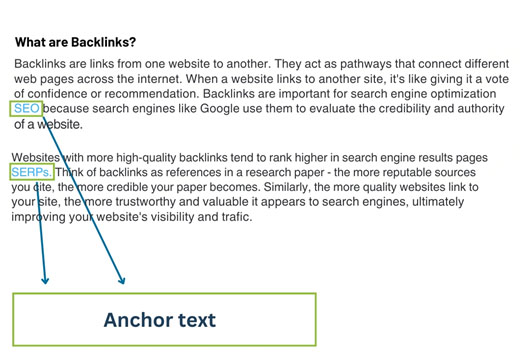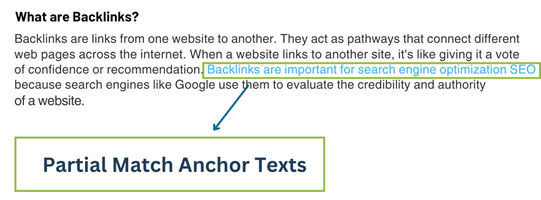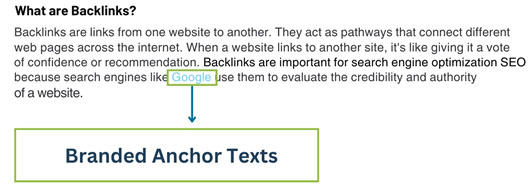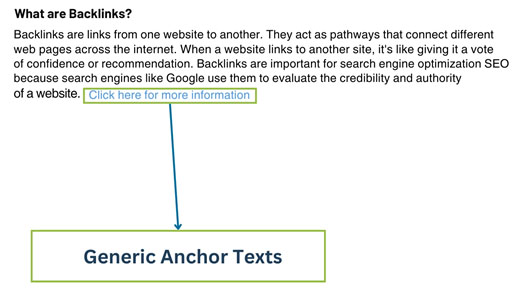Introduction
Anchor texts are the clickable words or phrases in a hyperlink that direct users to another webpage. They serve as signposts, guiding both users and search engines about the content of the linked page. In simpler terms, anchor texts are like road signs on the internet, helping us navigate through the vast web of information.

Understanding the importance of anchor texts in SEO is crucial for anyone aiming to improve their website’s visibility and ranking on search engine results pages (SERPs). Search engines like Google use anchor texts to determine the relevance and context of a webpage, which directly influences its ranking.
Types of anchor texts
Anchor texts are the clickable words or phrases in a hyperlink. They come in different types, each with its own purpose:
1. Exact match anchor texts: These include the exact keyword or phrase that you want to rank for in search engines. For example, if you’re targeting the keyword “best running shoes,” your anchor text might be “best running shoes.”

2. Partial match anchor texts: These contain variations of the target keyword or phrase. For instance, if your target keyword is “best running shoes,” a partial match anchor text could be “top-rated running shoes.”

3. Branded anchor texts: These use your brand name as the anchor text, such as “Nike” or “Amazon.” They help strengthen your brand recognition.

4. Generic anchor texts: These are non-specific phrases like “click here” or “learn more.” They’re versatile but don’t provide keyword optimization.

5. Naked URLs: These anchor texts are simply the URL of the page you’re linking to, like “https://www.example.com/page.”

Each type serves a different purpose in guiding users and search engines about the linked content.
What are the best practices?
Using anchor texts effectively involves several best practices that can boost your website’s SEO without risking penalties from search engines.
1. Relevance and context: Anchor texts should accurately describe the linked content and fit naturally within the surrounding text. This helps search engines understand the relationship between the anchor text, the linked page, and the overall topic.
2. Diversity in anchor text usage: Instead of using the same anchor text repeatedly, vary your anchor texts to include different keywords and phrases related to your content. This signals to search engines that your website offers a wide range of valuable information.
3. Avoiding over-optimization: Using too many exact match anchor texts or excessively optimizing anchor texts can trigger search engine penalties. Focus on creating a balanced mix of anchor texts that enhance user experience and provide value.
4. Incorporating long-tail keywords: Long-tail keywords are specific phrases that are less competitive but highly relevant to your content. Incorporating these into your anchor texts can help you target niche audiences and improve your chances of ranking for specific search queries.
5. Utilizing natural language: Anchor texts should flow naturally within your content and avoid sounding forced or spammy. Write anchor texts that sound like a genuine part of the sentence or paragraph to improve user experience and maintain credibility with search engines.
Optimizing anchor texts
Optimizing anchor texts for various platforms is crucial for enhancing SEO performance.
1. On-page optimization involves using relevant anchor texts within your website’s content to link to other pages on your site. These anchor texts should accurately describe the linked page’s content, improving user experience and search engine visibility.
2. Off-page optimization focuses on anchor texts used in external links pointing to your website. It’s essential to earn backlinks with diverse anchor texts from authoritative sites, signaling credibility to search engines.
3. On social media platforms, anchor texts play a role in posts, comments, and bio links. Use concise and compelling anchor texts to drive traffic to your website or specific pages.
4. In guest posts and backlinks, ensure anchor texts are relevant to the linked page’s content and contextually fit within the surrounding text. Avoid over-optimization and aim for natural integration to maximize SEO benefits.
By understanding how to optimize anchor texts across these platforms, you can boost your website’s visibility and credibility in search engine results.
Monitoring and measuring anchor text
Monitoring and measuring anchor text performance is essential to understand how they impact your website’s SEO.
A. Tools like Google Analytics, Ahrefs, and SEMrush can help track anchor texts. These tools provide insights into where your anchor texts are coming from and how they’re performing.
B. Key metrics to monitor include:
– Anchor text distribution: Ensure a diverse range of anchor texts to avoid over-optimization.
– Referring domains: Track the websites linking to you and the anchor texts they use.
– Click-through rate (CTR): Measure how often users click on anchor text links to gauge their effectiveness.
– Organic search traffic: Analyze changes in traffic to your site from search engines, influenced by anchor texts.
C. Analyzing the impact of anchor texts on SEO performance involves assessing how they contribute to your website’s visibility and ranking in search engine results. Look at factors like changes in search engine rankings, organic traffic, and conversions attributed to specific anchor texts. By evaluating these metrics, you can refine your anchor text strategy to improve SEO performance and drive more relevant traffic to your site.
Concluding remarks
In conclusion, effective anchor text usage remains a cornerstone of SEO strategy. Embrace emerging trends by prioritizing natural language and semantic relevance in anchor texts. Diversify anchor text profiles, monitor performance metrics closely, and adapt strategies based on evolving search engine algorithms. Ultimately, anchor texts should enhance user experience, providing valuable pathways to relevant content while signaling authority and credibility to search engines. By leveraging anchor texts effectively, businesses can bolster their SEO efforts and achieve sustainable online visibility.